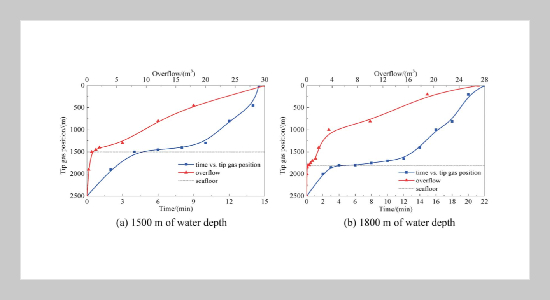X.H. Wang1,2, Z.C. Guan 1, Y. Tian1 and S.Q. Xu1
1 China University of Petroleum, Qingdao 266580, Shandong, P.R. China
2 University of Calgary, T2M 4C5, Calgary, Alberta, Canada
Received:
March 2, 2018
Accepted:
June 27, 2018
Publication Date:
December 1, 2018
Download Citation:
||https://doi.org/10.6180/jase.201812_21(4).0016
ABSTRACT
Gas influx is a phenomenon which causes serious outcome, and consequently the early and accurate detection of gas influx is crucial for deepwater drilling operation security. The detection method outside marine riser (DMOMR) is widely utilized in deepwater drilling as a complement of the traditional wellhead detection method (WDM). In this study, an extended two-fluid model (TFM) is developed to describe the gas-liquid two-phase flow when gas influx occurs and to compare the advantages of the DMOMR and the WDM in marine riser. By comparing the simulation results with the measured data of a well in the Bohai Sea, China, it is demonstrated that this model provides an excellent description for the gas-liquid two-phase flow in marine riser. The tip gas position, overflow and detection time are predicted using this model, and parameters such as water depth, wellbore depth, and formation permeability and equivalent density are controlled to vary respectively. The comparisons present that the DMOMR can detect gas influx in advance than the WDM under most conditions, and the lead time of the DMOMR increases by the increasing water depth and reducing wellbore depth. Moreover, the simulation results agree that the DMOMR has a great advantage in low or medium permeability (< 300 mD) formation and lower pressure formation. With the increase of formation permeability and formation equivalent density, the advantage of the DMOMR weakens compared with the WDM.
Keywords:
Deepwater Drilling, Gas Influx, Acoustic Detection, Two-fluid Model, Numerical Simulation
REFERENCES
- [1] Mcconnell, D. R., Z. Zhang, and R. Boswell (2012) Review of Progress in Evaluating Gas Hydrate Drilling Hazards, J. Marine & Petroleum Geology 34(1), 201223. doi: 10.1016/j.marpetgeo.2012.02.010
- [2] Chen, D. C., Y. Yao, et al. (2016) A New Model for Predicting Liquid Loading in Deviated Gas Wells, Journal of Natural Gas Science & Engineering 43,178184. doi: 10.1016/j.jngse.2016.06.063
- [3] Yin, H., P. Liu, and Q. Li (2015) A New Approach to Risk Control of Gas Kick in High-pressure Sour Gas Wells, Journal of Natural Gas Science & Engineering 26, 142148. doi: 10.1016/j.jngse.2015.06.014
- [4] Alhuthali, A. H., A. Datta-Gupta, and B. Yuen (2010) Optimizing Smart Well Controls under Geologic Uncertainty, Journal of Petroleum Science & Engineering 73(1), 107121. doi: 10.1016/j.petro.2010.05.012
- [5] Chen, P. and T. Ma (2014) Research Status of Early Monitoring Technology for Deepwater Drilling Overflow, Acta Petrolei Sinica 35(3), 602612. doi: 10. 1177/0022219412454455
- [6] Aziz, K. and G. W. Govier (1972) Pressure Drop in Wells Producing Oil and Gas, Journal of Canadian Petroleum Technology 11(3), 107121. doi: 10.2118/ 72-03-04
- [7] Beggs, D. H. and J. P. Brill (1973) A Study of Twophase Flow in Inclined Pipes, Journal of Petroleum Technology 25(5), 607617. doi: 10.1016/j. ijmultiphaseflow.1973.03.008
- [8] Mukherjee, H. and J. P. Brill (1985) Pressure Drop Correlations for Inclined Two-phase Flow, Journal of Energy Resources Technology 107(4), 549554. doi: 10.1115/1.3231233
- [9] Chen, D. C., Y. Yao, et al. (2015) Numerical Simulation on Fluid-carring Mechanism and Efficiency of Vortex Flow in Gas Wells, China Petroleum Machinery 43(9), 9194. doi: 10.106082/j.cnki.issn.1001-4578. 2015.09.021
- [10] Chen, D. C., Y. Yao, et al. (2016) A New Prediction Model for Critical Liquid-carrying Flow Rate of Directional Gas Wells, Natural Gas Industry 36(6), 40 44. doi: 10.3787/j.issn.1000-0976.2016.06.006
- [11] Calrolina, S., Avelar, et al. (2009) Deepwater Gas Kick Simulation, Journal of Petroleum Science & Engineering 67(12), 1322. doi: 10.1016/j.petrol.2009.03.001
- [12] Vajargah, A. K., et al. (2013) Feasibility Study of Applying Intelligent Drill Pipe in Early Detection of Gas Influx during Conventional Drilling, SPE-163445-MS.









